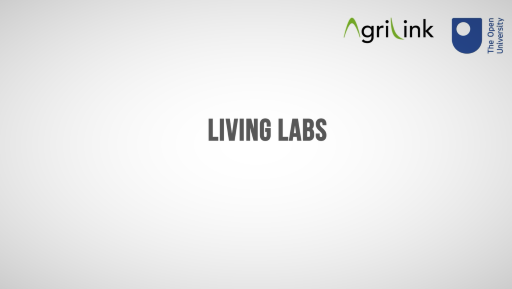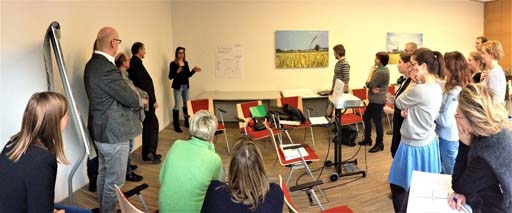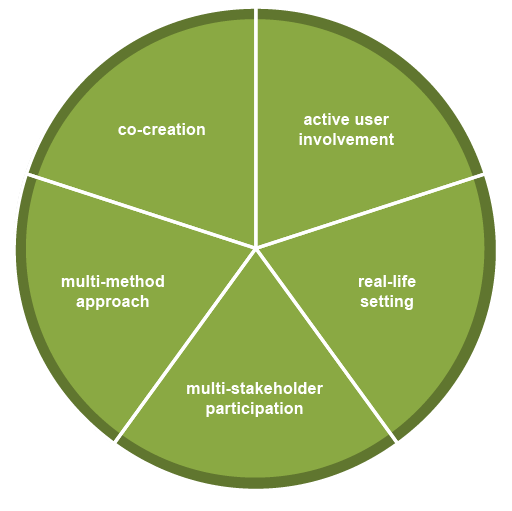Use 'Print preview' to check the number of pages and printer settings.
Print functionality varies between browsers.
Printable page generated Thursday, 18 April 2024, 2:49 AM
Session 1 Living Labs
Session 1 Living Labs

In this first session of the course we explain what Living Labs are. First, watch the following video on Living Labs and then do the reflective activity below.

Transcript
RALUCA BARBU:
In this session, we introduced the concept of 'Living Labs'. According to the European Network of Living Labs, they have five common elements, but many different ways in which these are put into practice. Living Labs aim to design and develop innovations by actively involving the expected users of those innovations.
This is done in real-life settings in which those users are working. It involves many different stakeholders within the real life settings. And the Living Labs use a wide range of methods to help design and develop the innovations. The involvement of users and stakeholders and the use of different methods are all aimed at supporting the co-creation of the innovation. In other words, Living Labs provide an arena in which innovative improvements to address real-life problems are designed and developed by sharing the knowledge and skills of all those with a strong interest in that innovation.
 Reflective Activity 2 – What are Living Labs?
Reflective Activity 2 – What are Living Labs?
Having watched the video, describe in your own words what you think a Living Lab would bring to agriculture using the text box below.
Answer
A Living Lab is a simple concept that deals with complex situations. It is a way of getting user involvement in the innovation process. In agriculture, farmers are the end user of innovations aimed at supporting agricultural production. And yet farmers are rarely the ones to devise such innovations. A wide range of people and organisations may be involved in researching and developing agricultural innovations. And often they do so without talking to or consulting farmers.
This ‘gap’ is often bridged by agricultural advisors, who can ‘translate’ research findings and associated innovations for farmers and can sometimes ‘translate’ the needs and wants of farmers to the scientists and innovators. Living Labs are a way of changing this linear approach to providing innovative agricultural services into a network approach by bringing together as many of the people involved to collectively define and devise new solutions to existing and emerging problems over a long period.
Now go to the next section.
Living Labs and knowledge
At their simplest, Living Labs are about collective ways of finding solutions to real-life problems in real-life settings. They also assume that the knowledge required to define and develop these new solutions does not just come from researchers, but also from the other participants in the Living Lab, and that this knowledge can be either tacit or explicit as explained by Genevieve Nguyen of INRA in France (see Box 1.1 below).
Box 1.1 Tacit and explicit knowledge
AgriLink Practice Abstract 26: Tacit and explicit knowledge: Their usefulness for changing practices
Since the 1950s, the promotion of the conventional agricultural model has been based on the dissemination of standardised technical messages from researchers to farmers, supported by agricultural advisors. The technical knowledge disseminated is part of a category of knowledge termed ‘explicit’ because it can be easily formalised and transferred.
Farmer-led innovation requires a second type of knowledge, termed ‘tacit’. Contrary to explicit knowledge, tacit knowledge is acquired through learning-by-doing, problem-solving and practical experiences. The farmer observes changes in his environment, identifies possible problems, searches for and experiments with solutions, corrects for errors, then chooses the most appropriate solution for him. By doing so, the farmer develops his skills and innovative capability.
Exchanges with other farmers within a community of practice and beyond foster the accumulation of tacit knowledge by allowing the entry of new members with different knowledge, and by developing deliberation and legitimation processes. Tacit knowledge can then be converted into explicit knowledge to facilitate its dissemination.
In this process, farmers are considered as experts and agricultural advisors become facilitators of the exchanges. Acknowledging the central role of tacit knowledge can thus help the different stakeholders – farmers, advisors and policymakers – to co-construct innovative technical references and agricultural services that meet the needs of each farmer and are adapted to an increasingly constrained and uncertain environment.
More information on this topic can be found in this AgriLink Theory Primer on Knowledge and organisational learning for innovation.
Types of Living Labs
Living Labs are not unique to agriculture, and they come in many forms. The different contexts and the different histories and traditions of those involved in them mean that the theory and practice behind Living Labs is still evolving.
For example, Schuurman et al. (2013) proposed a fourfold categorisation of Living Labs based on a literature review and validated by an empirical investigation of the characteristics of 64 Information and Communication Technology (ICT) Living Labs from the European Network of Living Labs (ENoLL).
The four types they defined were:
| 1. original ‘American’ Living Labs |
| 2. Living Labs as extension to testbeds |
| 3. Living Labs that support context research and co-creation with users |
| 4. Living Labs for collaboration and knowledge support activities. |
This categorisation highlights something of the history of Living Labs. They were first talked about in the USA in the 1990s where some researchers created home-like settings in laboratories to study the behaviour of individuals over periods of time (the original American Living Labs). An example might be to test out smart technologies but in a more controlled setting than a real house.
The concept has since evolved over the years, beginning in the early 2000s, and particularly in Europe (helped by the fact that the European Commission has been placing an increasing emphasis on the importance of multi-actor and transdisciplinary projects). One of the key elements of more recent Living Lab experiments or tests is that users are studied or involved in their everyday ‘real-life’ settings instead of in a recreated natural context in a laboratory setting.
This evolution has led to three other types of Living Lab depending on the extent of differences in the purpose and processes involved. Firstly, Living Labs that are an extension to test beds are like the original Living Labs but where the data gathering is done in a real-world setting and with some involvement from users and stakeholders.
The next category (number 3 in the list above) is more project focused with the research and co-creation work leading to initial testing and validation of innovation over a limited period.
The final type is less focused on testing and more on knowledge sharing amongst a community that sustains itself over time. This process of knowledge sharing in a community has also been called knowledge brokering as described by Sandra Šūmane and Tālis Tisenkopfs of the Baltic Studies Centre in Latvia (see Box 1.2 below).
Box 1.2 Knowledge brokering
AgriLink Practice Abstract 13: Knowledge brokering: facilitating innovation and joint learning
The concept of knowledge brokerage was developed in the context of linking research, policy and practice. It refers to a set of activities and processes aimed at exchanging and translating diverse individual knowledge stocks into collectively shared knowledge and innovations. Up until the 1990s, knowledge brokering was interpreted primarily as a linear transfer of scientific ‘ready-to-use’ knowledge or technology from researchers and advisors to farmers.
However, it has gradually been recognised that innovations leading towards more sustainable agriculture often emerge from, and are best advanced by, multi-actor learning networks where people from different contexts and with different backgrounds meet, interact and negotiate. Consequently, knowledge brokering is currently seen as an activity aimed at enhancing interactions, dialogue, mutual learning and direct collaboration between a range of actors, including farmers.
Agricultural advisory services can take a central role in this process by facilitating connections and knowledge exchange among various stakeholders for joint learning and innovation. Research suggests that knowledge brokering works best within a participatory approach to so-called boundary objects that are issues of interest to several different communities but viewed or used differently by each of them.
More information on this topic can be found in this AgriLink Theory Primer on Knowledge brokering, network learning, transition from ‘advisor’ to ‘facilitator’.
So, in summary, we can elaborate on the earlier typology list as follows:
| 1. Original ‘American’ Living Labs (a laboratory made to resemble the real-world for research on a small scale focusing on behaviour). |
| 2. Living Labs as extension to testbeds (environments within which users and stakeholders can collaborate in the creation and validation of services). |
| 3. Living Labs that support context research and co-creation with users (environments aimed to support innovation processes focusing on the early development phases of needs analysis and early design). |
| 4. Living Labs for collaboration and knowledge support activities (a focus on collaborative platforms, knowledge sharing and community development). |
This is one typology based heavily on ICT-focused Living Labs. While Leminen et al. (2012) made their typology focus around which actor drove the activities (utilizer-driven, enabler-driven, provider-driven and user-driven), Zavratnik et al. (2019) have reviewed how Living Labs have operated in rural areas.
More work on Living Labs is being done all the time, but the work so far, and the work of ENoLL in general, has drawn out some key characteristics of Living Labs.
The key elements of Living labs
ENoLL (in late 2020) defined Living Labs on their website as:
‘user-centred, open innovation ecosystems based on systematic user co-creation approach, integrating research and innovation processes in real life communities and settings.
LLs are both practice-driven organisations that facilitate and foster open, collaborative innovation, as well as real-life environments or arenas where both open innovation and user innovation processes can be studied and subject to experiments and where new solutions are developed.
LLs operate as intermediaries among citizens, research organisations, companied, cities and regions for joint value co-creation, rapid prototyping or validation to scale up innovation and businesses. LLs have common elements but multiple different implementations.’
The common elements of a Living Lab that they note, and which were set out in the introductory video to this session, are:
| 1. active user involvement |
| 2. real-life setting |
| 3. multi-stakeholder participation |
| 4. multi-method approach |
| 5. co-creation. |
These five elements are set out as a cycle in Figure 1.1. We will return to these elements when we look at the AgriLink Living Labs in Session 2, but first I want to finish this session by briefly looking at the many types and forms of innovation highlighted in the Living Lab and agricultural practitioner communities.
The nature of innovations, knowledge exchange and practices
 Reflective Activity 3
Reflective Activity 3
Spend five minutes writing down in the text box below what words have been used alongside innovation that you have heard or read about and that may be relevant to agriculture. Also note where you think these innovations come from and how they relate to knowledge and practices as described in Box 1.1.
Answer
My list came out with product innovation, process innovation, user innovation, open innovation, radical innovation, and incremental innovation. There are others. Indeed, I have just remembered eco-innovation as well. The point to note here is that some refer to what is being innovated and others refer to how the innovation happens; any innovation has many different aspects to it and many different people involved.
Farming is a complex human activity system with many actors and many components. Farming is also an activity that has, in recent decades, been ascribed two major, but potentially conflicting, objectives: the short to medium term production of sufficient food to support socio-economic driven needs of security and stability, and the medium to long term philosophical and aesthetic desire to manage and conserve the ‘natural world’.
While there have been attempts to reconcile these different objectives both theoretically, as with the concept of ecosystem services, and practically, through agri-environment schemes, all too often these innovations have been developed through explicit knowledge and been provided for farmers by others without enough regard to the farmers’ own practices and contexts.
This contrasts with innovations and practices being developed with farmers, using their tacit or experiential knowledge to shape those innovations and practices both before and after adoption and implementation.
If external knowledge and innovations are to support more sustainable forms of agriculture, then they must also be matched with an understanding of the practices and contexts in which they are to be deployed.
This includes the way in which an innovation can spread amongst farming communities as explained by Boelie Elzen from Wageningen Research in the Netherlands (see Box 1.3 below).
Box 1.3 Anchoring and scaling
AgriLink Practice Abstract 16: Anchoring and scaling of innovations in agriculture
To spread an innovation to more farmers beyond the few who already adopt it, one needs to understand in which stage the innovation is. Two such stages are called ‘anchoring’ and ‘scaling’.
Anchoring: in this stage an innovation is still under development and applied by a small number of ‘innovator-farmers’. Although innovation still has uncertainties and/or drawbacks, these farmers do not see this as a barrier, but rather as a challenge to tackle. The main objective in this stage is to develop the innovation further based on learning experiences from practice.
Scaling: in this stage an innovation has been demonstrated to work in practice by a significant number of farmers. It is considered ‘ripe’ for further application by ‘follower-farmers’. Yet, there may still be significant challenges to achieve this, e.g. need to invest, need to adapt farming practices, etc.
The practical relevance of this distinction is that, when considering an innovation, a farmer should assess whether it is in the anchoring or the scaling stage and whether the farmer sees her- or himself more as an innovator or as a follower. This can help to decide whether or not to start applying the innovation. The distinction should also be taken into account by advisors when advising a farmer.
Such an assessment is also of relevance for other stakeholders, including suppliers (to identify needs for further development), investors (to realise whether they invest primarily in ‘learning and development’ or in ‘marketing'), and policy makers (as different policy instruments are needed to stimulate either anchoring or scaling).
More information on this topic can be found in this AgriLink Theory Primer on Multi Level Perspectives (MLP) – Anchoring and scaling.
It is this interplay between innovations, knowledge exchange and practices and how they can be facilitated that lies at the heart of Living Labs, which we will look at in more detail in the next session.
However, you may also want to watch this video on Living Labs in AgriLink that was produced during the project that provides another overview of the processes involved.
Summary of Session 1
This session has introduced the key features of Living Labs and how they can play a role in devising innovative agricultural advisory services. They are user-centred, open innovation ecosystems based on the co-creation of innovative solutions.
Both active user involvement and multi-stakeholder participation combined with the use of a multi-method approach enables the integration of research and innovation processes in real-life communities and settings. They change the dynamics about how knowledge is developed and shared amongst those involved in the Living Lab.

References for Session 1
Leminen, S., Westerlund, M., and Nyström, A.G. (2012) ‘Living Labs as open-innovation networks’, Technology Innovation Management Review, 2(9): 6-11.
Schuurman, D., Mahr, D., De Marez L., and Ballon, P. (2013) ‘A fourfold typology of living labs: An empirical investigation amongst the ENoLL community’, 2013 International Conference on Engineering, Technology and Innovation (ICE) & IEEE International Technology Management Conference, The Hague, 2013, pp. 1-11.
Zavratnik, V., Superina, A., and Stojmenova Duh, E. (2019) ‘Living Labs for Rural Areas: Contextualization of Living Lab Frameworks, Concepts and Practices’, Sustainability, 11(14), p.3797.
Go to Session 2: The nature of innovative agricultural advisory services
